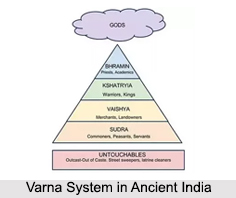Varna System in Ancient India formed the basic structure of Hindu society. It is among the world’s oldest forms of surviving social stratification. Varna system divided the society into four major sections based on the occupation of the people. Varna System in Ancient India was based on occupation, but with time it turned to a rigid caste system. ‘Varna’ literally means group in Sanskrit. With the advent of the Aryans, the ancient Indian society got divided into four sections - Brahmin, Kshatriya, Vaishya, and Sudra. In Hinduism, the Varna System was based on class, colour, guna, and yoga. Varna System in Ancient India was based on occupation, but with time it turned to a rigid caste system. ‘Varna’ literally means group in Sanskrit. With the advent of the Aryans, the ancient Indian society got divided into four sections - Brahmin, Kshatriya, Vaishya, and Sudra. In Hinduism, the Varna System was based on class, colour, guna, and yoga.The first 3 Varna is called twice born. It implies that they have come of age and are eligible to study Sanskrit and the Vedas and perform Vedic rituals. The thread ceremony marks the second birth among the Indian male. For girls it is during their marriage that a thread is tied round their hands to mark the second birth. Besides Hindus, this custom is also prevalent with the Jains. |
No comments:
Post a Comment